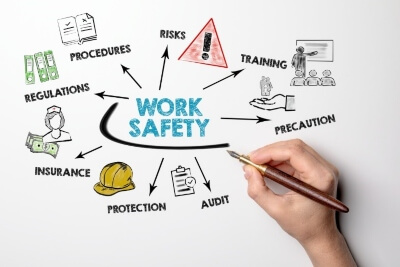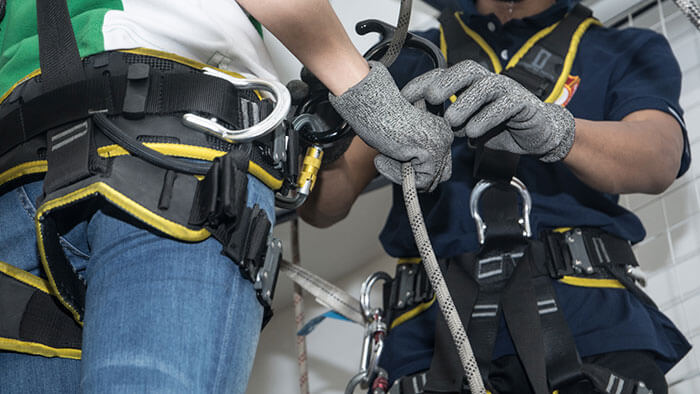As an occupational health and safety trainer, I teach about many different topics. Some days I am focusing on JHSC over Zoom or in a boardroom – then other days, I am on a construction site teaching rough terrain forklift safety.
To be honest, the variability and the constant challenges are why my job can be so fun! The hours of driving? Well, not so much.
That being said, I get to see so many different workplaces and better understand hazards in these workplaces.
Every client I visit, just like every group I teach, has something unique to their environment and their people. For me, being able to spot these anomalies in my everyday life is like the trick to being an effective trainer.
How can I tailor that material to this particular client, moreover to this particular group of participants?

The 4 Stages of Competence
What I use is called “The Four Stages of Competence” (or if you ask my boss Dave – Learning).
This concept is covered in our Adult Teaching Foundation as part of the Train-the-Trainer programs, but I actually use it in every course.
As a trainer, it tells me where the knowledge level is and how I should go about conveying the information – but for participants – I want them to use this behavioural model to better understand hazards in the workplace.
The logic is that if you understand how the hazard came to be, then the most appropriate control measure for the circumstances can be implemented.
In fact, although the courses I teach vary from day to day, going through the “Four Stages” actually has become part of my opening lines – I am not preachy though, I sneak it into the introductions. So let’s work through them together.
Unconscious Incompetence
The first stage of the model is called unconscious incompetence.
It is the phase of learning that describes the beginning stage of the learning process. Unconscious incompetence is when individuals are unaware of what they are currently doing is not the way it should be done.
The training process begins with the participant’s knowledge of this error and acceptance that it needs to be changed; you don’t know what you don’t know.
Depending on the course topic, I tie in an example. For our purposes here, let’s choose something most of you will be familiar with – driving.
In the first stage, I have been known to refer to as blissful ignorance.
You know nothing, nor do you really care. Now that’s probably none of you, but imagine kids. They cannot start your car (hopefully lol), they do not really think about climbing underneath, and if you aren’t careful, they can even run into traffic.
I’ve read enough news stories about home accidents involving kids and cars for a lifetime – but as adults, it’s our job to keep them safe – they just don’t know.
This might also apply to the workplace with customers, clients, new hires, etc.
Conscious Incompetence
The second stage is conscious incompetence. It is the phase of learning in which the individual understands that the process they have followed in the past is incorrect and now needs to be corrected.
During this phase, participants begin to determine precisely what must be fixed in the process and how to apply what they have learned to ensure it is being done correctly moving forward.
In this stage, you know enough to know there are things that you don’t know.
Now for our driving example, let’s go back to when you were a little younger, finally, of the age where you get to start thinking about operating the vehicle.
You have seen friends or parents drive, and in your mind, it looks pretty easy. You sit in that seat, wheel in front of you, the shifter for forwards and backwards to your side. Looks pretty straightforward!
You see two pedals on the floor – perfect! You have two feet. Makes perfect sense – until it doesn’t.
Rather quickly, I’d imagine. To become proficient in operating that vehicle, you will need some practice.
Even when you have the basics down, a change in a variable such as snow on the roads can cause you issues. Here in the workplace, we still find new hires and staff who may not do a task or job often.
Conscious Competence
The third stage of the model is conscious competence. It is the learning phase in which the participant now possesses the knowledge they require and begins to apply it to the task.
Since they are still in the process of trying to correct “bad habits,” they pay closer attention to their actions to ensure the knowledge they have acquired is applied correctly.
This may often involve the individual performing at a slower pace. In this stage, you know enough to perform the task safely as per the training you received.
Here we have arrived. This is the stage as a trainer I want you to be in – I call it the good old “eyes on task, mind on task.”
You know what you do when you do it, why you are doing it.
For driving, there was a time and place you did this perfectly. Who remembers their driving test? Ya, that road test you took at the MTO or Drive Test Centres, that one.
Think back – where were your hands on the wheel? When you came up to an intersection, did you do the left, center, right checks? Of course, you did – in fact, I guarantee you animated the motions, so they saw you do it.
At that moment in time, you were consciously competent in operating that vehicle. In the workplace, whatever the topic or action is, this is where we want our workers.
Unconscious Competence
The fourth stage is unconscious competence. It is the phase of learning in which the individual has focused on ensuring they follow the information they have practiced to a point where they now follow what they learned without focusing on the information.
This is when the new behaviour can be called a habit or routine.
At this stage, you know what you need to know and can do it correctly without even thinking about it.
Our driving example will really shine here.
So in the previous stage, remember I asked where were your hands on the wheel for your road test? What about now? Wait, don’t answer that.
I don’t want to know you can drink a coffee, text on the phone, eat a sandwich, change gears, and drive at the same time.
We have arrived at our bad habits and complacency.
I’m sure you are aware that complacency kills, but getting to our fourth learning stage is a natural occurrence. I tell new equipment operators that you get good, then you get fast.
In the workplace, we have to watch that workers are not falling too far into this stage before being given a refresher to bring them back to conscious competence.

Image source: UKCPD
So there you have it, “The Four Stages of Competence.”
When you think about it, this comes down to behavioural safety. We have the ABCs.
A is the antecedent event, something that triggers actions.
B is the behaviour, what the worker does as a result.
C is the consequence, what positive or negative outcome will influence the behaviour.
If you have workers in the first two stages of competence, then training is a great option to achieve the desired behaviour. Fourth stage workers also require training, but for different reasons.
As a trainer, I get one of three comments from a fourth stage person in a course:
Firstly, “I knew that” – conformation of knowledge, reinforcing their competence.
Two, “Hey, I knew that, but I forgot, thanks for reminding me” – bringing them back to conscious competence.
Three, “Where the heck did that one come from?” – Rules and laws change, so do best practices – can’t allow complacency to take hold in any area of your workplace.
Question for you, though – now where will your hands be on that wheel?
Geoff Rowatt | CHRL
Industrial Safety Trainers Inc.





